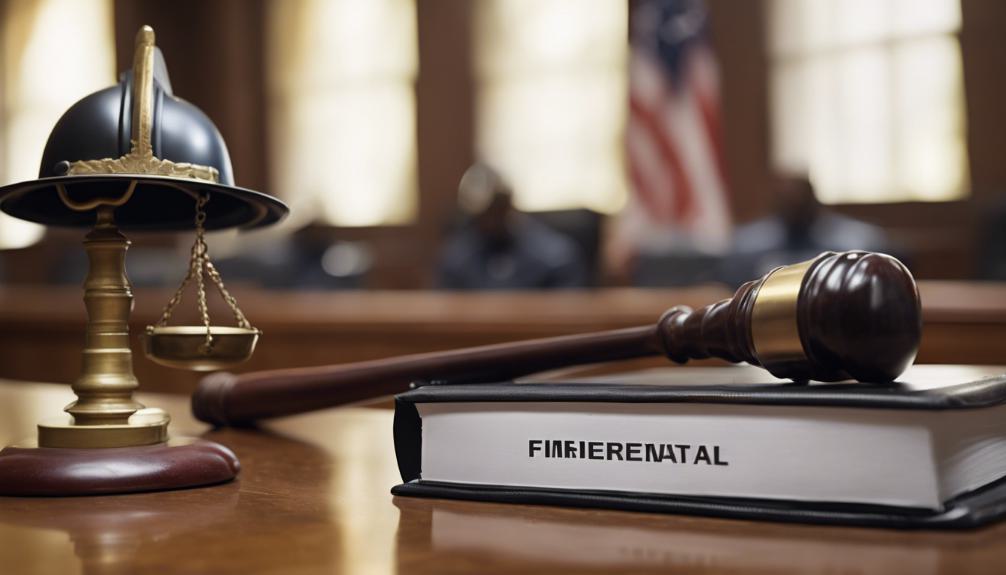Military Firefighter Lawsuit
We've often heard theories about the dangers of firefighting foam, especially for military firefighters exposed to toxic PFAS chemicals. It's alarming to think that those who protect us might be at risk themselves, facing serious health issues like cancer. With lawsuits now being filed seeking compensation for these health issues, we're left wondering about the extent of exposure and the potential outcomes for those affected. How will these legal actions unfold, and what does it mean for future safety protocols? This situation raises vital questions that demand our attention and further exploration.

Key Takeaways
- Military firefighters are suing AFFF manufacturers for cancer and health issues linked to PFAS exposure.
- Legal actions aim to secure compensation for affected individuals' medical expenses, lost income, and suffering.
- Lawsuits involve multiple U.S. military bases with high PFAS contamination levels in groundwater.
- Attorneys play a crucial role in achieving justice and compensation for the harm caused by PFAS exposure.
Firefighting Foam Dangers

We've discovered that AFFF firefighting foam, used extensively on military bases, contains PFAS chemicals that are linked to a slew of serious health issues, including cancer. This toxic firefighting foam has been a staple in military fire suppression efforts for decades, but its legacy is marred by the devastating impact on the health of those exposed to it, particularly firefighters. The connection between PFAS and various forms of cancer, such as kidney, testicular, bladder, and thyroid cancer, is alarmingly strong.
The dangers of AFFF exposure are most acute for military service members who've had high levels of contact with the foam, especially during training exercises. These brave individuals, dedicated to protecting us, find themselves facing an unseen enemy that can have life-altering consequences. It's not just the immediate environment that suffers; the persistence of PFAS, often dubbed 'forever chemicals,' means that once contamination occurs, whether on land or in water sources, the impact is both long-lasting and widespread. Many military installations are now grappling with the reality of PFAS in their drinking water, a direct result of AFFF use, posing significant health risks to anyone exposed.
PFAS Chemical Exposure

We've uncovered that exposure to PFAS chemicals poses serious health risks to military firefighters, including increased cancer risks. Legal actions have been initiated in response to these findings, aiming to address the repercussions faced by those affected. It's vital we examine the implications of these health risks and the steps being taken to mitigate them.
Health Risks Identified
Exposure to PFAS chemicals, through AFFF firefighting foam, has been conclusively linked to a range of severe health risks, including various forms of cancer. We've learned that those of us exposed to these chemicals are at a heightened risk for kidney cancer, testicular cancer, bladder cancer, and thyroid cancer. Furthermore, the dangers don't stop there. We're also facing the possibility of birth defects, high cholesterol levels, and significant immune system changes, including disruptions and hormone imbalances. Conditions such as colorectal cancer further underscore the critical health impacts of PFAS exposure. It's become clear that the repercussions of exposure to these chemicals are profound, affecting not just our own health but potentially the well-being of future generations.
Legal Actions Taken
Given the severe health risks identified from PFAS exposure, military firefighters have initiated legal actions to seek justice and compensation. We're targeting both the manufacturers of AFFF firefighting foam and the military bases where our exposure occurred. These lawsuits are vital for us to address the cancer and other serious health issues we've developed due to prolonged contact with PFAS chemicals.
Our collective aim is to make sure that those responsible are held accountable for their roles in our exposure. We're fighting for compensation to cover our medical treatments and provide some relief for the pain and suffering we've endured. With many of us now eligible to file lawsuits based on documented PFAS exposure, we're leaning heavily on legal assistance to navigate these complex legal battles against the manufacturers and military bases involved.
Military Bases Affected

Numerous military installations, including Camp Lejeune and Eglin Air Force Base, have been impacted by PFAS contamination due to the use of AFFF. This firefighting foam, essential for combating fuel fires, has unfortunately led to high concentrations of PFAS chemicals in the groundwater near these bases. We're now seeing the repercussions of this extensive historical usage, not just in environmental degradation but also in potential health risks for our service members.
It's not just these bases that are affected. Peterson Air Force Base, Robins Air Force Base, and Wright-Patterson Air Force Base have all reported similar PFAS contamination. The issue is widespread, touching numerous corners of our nation's defense infrastructure. The Department of Defense is taking steps to address these concerns, recognizing the urgent need to protect both our environment and the health of military personnel.
Legal actions have been initiated in response to this contamination, underscoring the seriousness of the situation. As we continue to grapple with the environmental consequences of AFFF usage, it's clear that a thorough strategy is required to mitigate further damage and make certain the safety of our service members.
Health Risks Identified

We've identified significant health risks associated with military firefighters' exposure to toxic chemicals, including long-term respiratory issues and a marked increase in cancer risk. Our findings highlight the urgent need for addressing these hazards, as they pose a severe threat to the health and well-being of these dedicated professionals. It's imperative we explore potential solutions and support for those affected.
Exposure to Toxic Chemicals
While serving their country, military firefighters face an elevated risk of developing various cancers and health issues due to exposure to toxic PFAS chemicals found in AFFF firefighting foam. These hazardous substances are linked to a range of serious health issues, including bladder, breast, leukemia, liver, and other types of cancer. Additionally, the accumulation of PFAS chemicals in the body over time can lead to thyroid disease and ulcerative colitis, further increasing the cancer risk for those exposed. For military firefighters diagnosed with cancer potentially stemming from PFAS exposure, there's a pathway to seek legal compensation. This recognition of the health risks associated with exposure to toxic chemicals underscores the need for better protective measures and support for our service members.
Long-Term Respiratory Issues
In addition to the risks of cancer, military firefighters also face serious long-term respiratory issues from prolonged exposure to AFFF. The inhalation of PFAS chemicals, a major component in AFFF, has been linked to a range of respiratory problems, including asthma and bronchitis. Studies have consistently shown a correlation between AFFF exposure and increased respiratory issues among us, highlighting the dangers of chronic exposure during firefighting activities. This has not only exacerbated existing conditions for some but also raised concerns about our long-term health. As a result, many of us are considering legal recourse to seek compensation for these health risks. The acknowledgment of these risks has been a critical step in our fight for justice and recognition of the sacrifices we've made.
Cancer Risk Increase
Our exposure to AFFF firefighting foam considerably elevates our risk of developing various cancers, including bladder and breast cancer, due to the toxic PFAS chemicals it contains. As military firefighters, we're not only battling blazes but also the heightened risks of leukemia, liver, and other specific cancers directly linked to PFAS exposure. Studies have clearly associated this exposure with an increased cancer risk, underscoring the severe health consequences we face. The accumulation of PFAS chemicals in our bodies over time is a pressing concern, leading to an array of severe health consequences. We're fighting on two fronts: against the immediate dangers of fires and the prolonged battle against the toxic effects of AFFF, with its increased cancer risk casting a long shadow over our health and well-being.
Legal Actions Initiated

We've kicked off multiple lawsuits against companies like 3M Company, Ansul, and National Foam for exposing us to harmful PFAS chemicals through AFFF. As military firefighters, we're confronting the serious health issues, including cancer, that have arisen from our duty-related PFAS exposure. These legal actions are vital for us; they're not just about seeking compensation. They're about holding manufacturers accountable for distributing AFFF containing these toxic chemicals, without adequate warnings of the risks involved.
Our fight in court is for justice and to highlight the dangers we've faced due to prolonged exposure to PFAS. The health consequences we're now experiencing, such as increased cancer risks, are a direct result of our commitment to serving and protecting. By initiating these lawsuits, we're not only seeking recompense for ourselves but also aiming to ensure that future military firefighters are safeguarded against similar exposure.
The manufacturers' accountability is paramount in this battle. Our hope is that these legal actions will bring about significant changes in how AFFF is produced and distributed, prioritizing the health and safety of firefighters over profits.
AFFF Usage History

Since the late 1960s, the U.S. Department of Defense has mandated the use of Aqueous Film-Forming Foam (AFFF) to combat high-intensity fires, exposing military firefighters to significant health risks. This firefighting foam, integral in quelling fuel fires common in military settings, has been a staple across all military branches, from the Army to the Navy, Air Force, and Marines. For decades, we've relied on AFFF for its unparalleled effectiveness against gasoline, oil, and other flammable liquids' fires.
However, our dependence on AFFF has come with unintended consequences. The foam's key ingredients, per- and polyfluoroalkyl substances (PFAS), are not only persistent in the environment but also accumulate, leading to widespread contamination. This contamination has seeped into soil, groundwater, and even our drinking water sources on military bases, posing long-term health risks to us and our families.
As we reflect on our history with AFFF, it's clear that its role in firefighting has been pivotal. Yet, the legacy of PFAS contamination and the associated health risks it brings to military personnel cannot be overlooked. Our commitment to protecting lives from fires has inadvertently exposed us to new threats, highlighting the complex challenge of balancing safety and health in military operations.
VA Disability Claims

Reflecting on the history of AFFF use and its unintended consequences, it's important to explore how military firefighters can file VA disability claims for health issues stemming from exposure to this toxic foam. The process requires a clear link between AFFF exposure and the resulting health complications, including cancer diagnoses. To successfully navigate VA disability claims, military firefighters must meticulously gather evidence, such as medical records and detailed documentation of their exposure to the hazardous foam.
For those of us who've served as military firefighters and are now facing health issues due to AFFF exposure, understanding the importance of evidence cannot be overstated. The VA requires concrete documentation that directly connects our health problems to our service and, specifically, to our exposure to toxic foam. This means collecting all relevant medical records, which substantiate our health conditions, and any documentation that can prove our exposure to AFFF during our service.
Successfully filing VA disability claims is pivotal for accessing the VA benefits we need and deserve. It's a challenging process, no doubt, but one that's essential for us to undertake. Armed with the right evidence and documentation, we can secure the VA benefits that acknowledge the sacrifices we've made.
Compensation Strategies

Managing compensation strategies is essential for military firefighters seeking justice for health issues caused by AFFF exposure. We're focused on ensuring that our legal approaches are tailored to address the unique challenges faced by those affected. Our strategies aim at securing compensation that covers medical expenses, lost income, and the pain and suffering endured due to PFAS exposure. It's not just about addressing immediate financial needs; we're also looking at long-term support for ongoing treatment and rehabilitation costs.
Our experienced attorneys are adept at maneuvering the complexities of these lawsuits, ensuring that military firefighters receive the compensation they deserve. We grasp the intricacies of calculating the extent of harm caused by AFFF exposure, which is paramount in determining the appropriate compensation amount. This includes not only current financial burdens but also future care needs.
Furthermore, we are prepared to pursue punitive damages where applicable. Such damages are crucial in holding responsible parties accountable for their negligence. It's more than just a legal battle; it's about ensuring justice and providing a sense of closure to those who've put their lives on the line. Our thorough compensation strategies are designed to offer financial relief and support through this challenging journey.
Selecting Legal Representation

Choosing the right legal representation can make a significant difference in the outcome of a military firefighter lawsuit. We're looking for experienced lawyers who offer a free consultation and case evaluation right off the bat. It's important for us to understand our eligibility and options without any financial commitment. We've learned that a legal team with a successful track record in AFFF-related cases is important for efficient representation. Their expertise can greatly increase our chances of recovering compensation.
Additionally, we prefer nationwide representation, as it brings a wealth of experience from various jurisdictions, enhancing the strategy for our case. Opting for lawyers who work on contingency fees is also important to us. This arrangement offers financial relief, as we won't have to pay upfront fees. It ensures that our legal team is motivated to win our case.
Frequently Asked Questions
What Is the Average Payout for the AFFF Lawsuit?
We're curious about the average payout for AFFF lawsuits, and it seems it varies widely. Settlements can range from thousands to millions, depending on exposure, health issues, and legal evidence. It's a complex issue.
Is the AFFF Lawsuit Real?
Yes, it's real. We've seen thousands of cases against the manufacturers of toxic firefighting foam. It's a serious issue affecting many, and we're looking into legal avenues to seek compensation for health issues caused by AFFF exposure.
Who Qualifies for the AFFF Lawsuit?
We're wondering who's eligible for this lawsuit. It's about those exposed to a specific firefighting foam and diagnosed with certain cancers linked to it. We've learned there's a time limit to file, so we're gathering info fast.
What Is the Navy Firefighting Lawsuit?
We're looking into legal action where individuals are suing due to health issues from a specific firefighting foam. They're aiming for compensation and highlighting the importance of holding responsible parties accountable for their actions.

This post has been generated by AI and was not reviewed by editors. This is Not legal advice. Please consult with an attorney.




